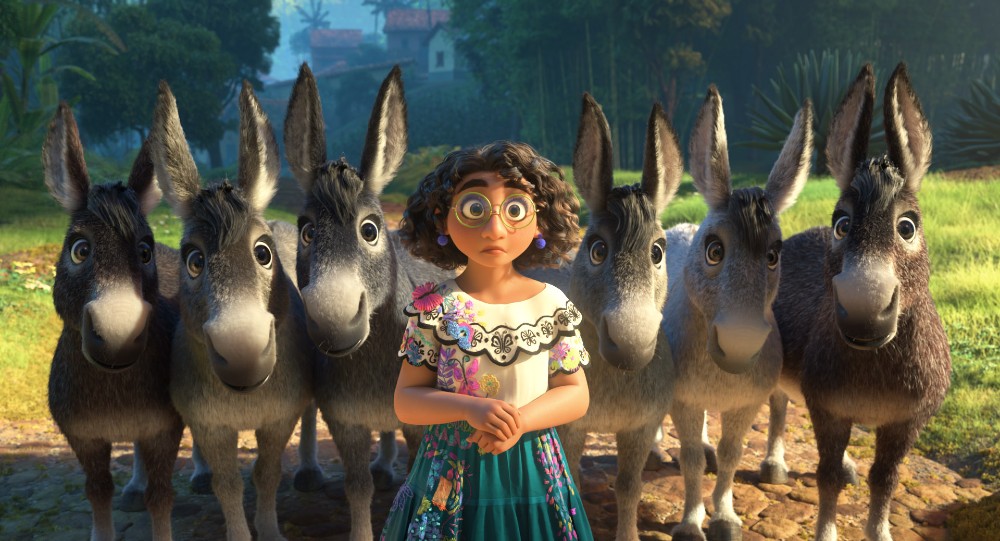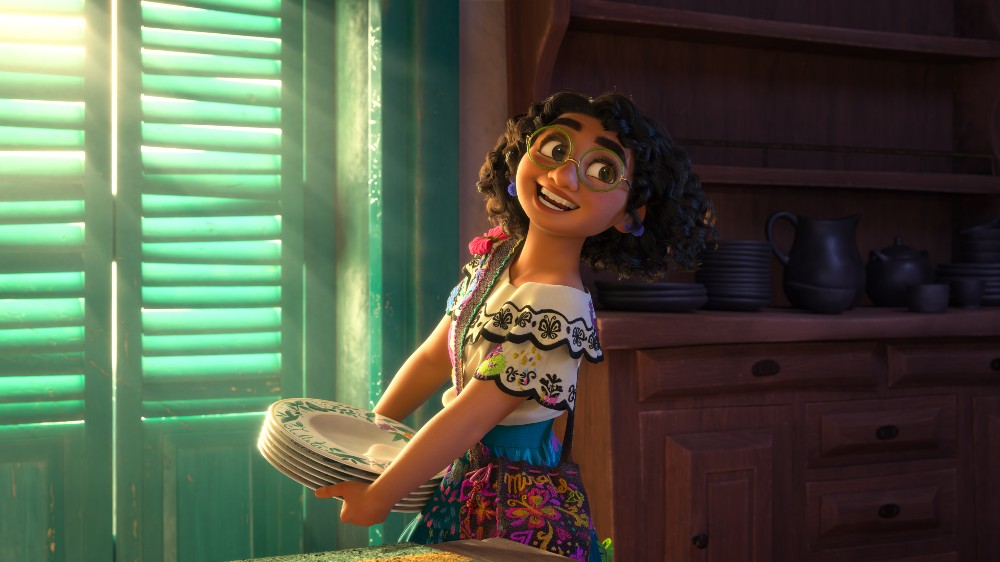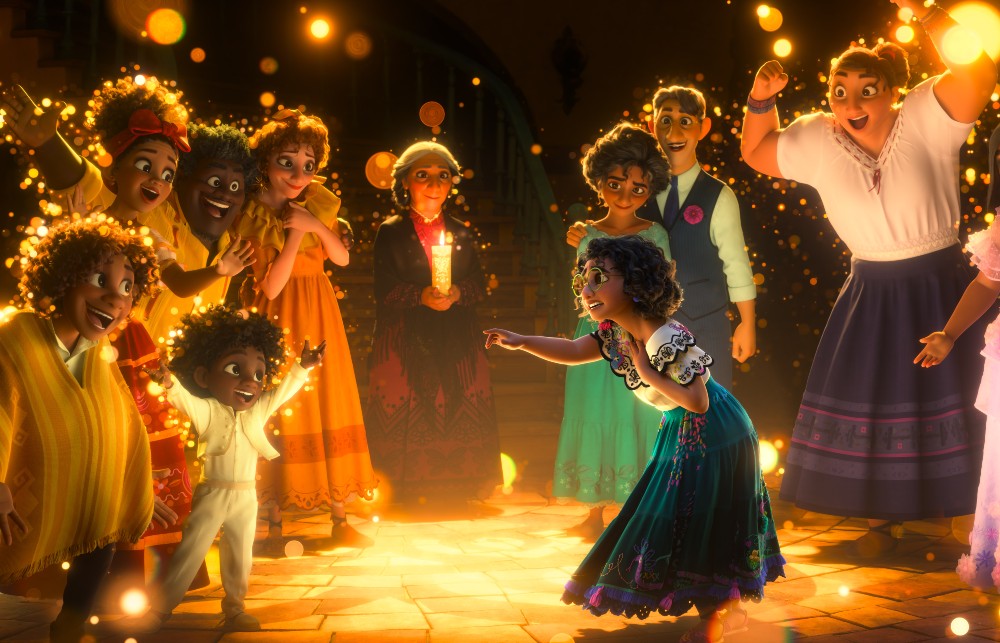
The busy sound I heard right before the credits roll for Disney’s upcoming magical film Encanto was not only the voice of Colombian singing legend Carlos Vives, intoning the movie’s surefire Oscar contender, “Colombia, Mi Encanto.” The clackity-clack was actually the busy feet of scurrying film critics rushing out to figure out what “Encanto” means and how the word and its synonyms may be cleverly used to describe the many ways in which Walt Disney Pictures Animations’ 60th animated feature brings smiles to all the faces in the family.
“Encanto” in Spanish principally means “charm” and, like the English word, can be both a verb or a noun. Given the title of this movie, not to speak of its vivacious colors, catchy songs, and humanistic messages, do not be surprised, therefore, to read “captivates,” “enthralls,” “enraptures,” “bewitches,” “hypnotizes,” “beguiles,” or “mesmerizes” in the review titles. Encanto does all that and more behind the steady hand of co-directors Byron Howard and Jared Bush, who together directed Zootopia.
The story opens with Alma, the matriarch of the Madrigal family, escaping unspecified violence in the Colombia jungle, her three babies in her arms. Her husband is not so lucky, succumbing instead to shadowy, horse-riding baddies swinging machetes. In his wake, Alma (later to be Abuela Alma) inherits a candle that soon reveals magical powers. The candle’s swirling flame yields Alma and her children a magical house that moves and cleans up after itself. Better yet, the legend behind the magic dons a new gift to each new blood member of the Madrigal family upon reaching the age of six in a sort of rite of passage type ceremony. Well, that is until poor, dopey little Mirabel Madrigal comes alone.
Encanto centers around what happens after the quirky and imperfect Mirabel (voiced by Stephanie Beatriz, who we saw earlier this year in In the Heights) is the only one not chosen for a gift. Before we get there, though, it is the construct of the enchanted family that gives Encanto, at a basic level, its titular charm, and provides many of the movie’s early laughs. There is Mirabel’s mother Julieta (Colombian actress Angie Cepeda), who can cure physical illness by feeding the patient a delicious “arepa,” there is Mirabel’s sister Luisa, who dons Samson-like supernatural strength, as well as her sister Isabela, who is perfect in every way, a thinly-veiled reference to the annoyingly and perfectly beautiful Princess Aurora. Mirabel also has an aunt who can control the weather, a cousin who can shapeshift, talk to animals, and a cousin who can hear even the drop of a pin, all just one little family tree branch away.
Given this amusing array of paranormal powers around her, Mirabel got the short end of the stick when she was rendered gift-less after her own initiation ceremony with the enchanted candle. But, when a prophecy of doom comes to Mirabel’s vision, she will have to use her bravery and wit to save her family and its legend from being extinguished. Other well-known Hispanic actors round out the talented voice cast, including singer Maluma, actor/comedian John Leguizamo, and actor Wilmer Valderrama. It is a who’s who of talent arrayed by Disney to send a subtle but important signal: Latin American talent extends beyond Mexico’s borders. What they did for Mexico with Coco, they can and do again with Encanto.
The setup may seem contrived yet simple, and even clichéd, but it is not. Thank the voice talent I just recited, the sincerity of the Mouse House’s intention, and screenwriter Charise Castro Smith for imbuing Encanto with soft tones of regional folklore or fairytales, much like writer Adrian Molina did for Coco while touching on different themes. That contrast, in fact, is critical. For the 2017 film, the themes focused on Mexico’s ghostly obsession with death and dying, with spirits, skulls, and animas. For Encanto, the theme is fundamentally different. In Colombia, the notion of magical realism augmented and superseded native beliefs. You half expect Garcia Marquez to make a cameo in this movie, given Encanto’s focus on large, doomed families, on strange powers, on small mysterious towns, and on a story that spans generations. For Mexican folklore, the question is what happens after we die or at a minimum what relationship does those who have gone have with the living. For Colombia mythology, by contrast, the issue is: “What is plausible from the world of spirits and magic today, among the living?”
In other words, Encanto is a good film because of its fealty to its subject matter. And that authenticity does not stop at the door of Castro Smith’s prose. It also spills seamlessly into Germaine Franco’s soundtrack, and by Lin Manuel-Miranda’s songwriting. Franco is a master at adapting local sounds—again, her Coco credit helps tremendously—and the reggaeton, Vallenato, Latin pop tunes with which she infused the superb songs of this film all combine to produce yet another successful Disney musical repertoire.
But as pitch perfect as the song, the script, the diverse characters, and the jokes all are, Encanto’s best attribute is also its most important: its animation. Through a rich tapestry of spinning, bright colors, the filmmakers create a sort of green/pink/purple world of flowers and household furniture, of mountains, valleys, and animals. This universe, which consists just of a little village, stands out for both its magic and for its realism. Rendering images that appear both human-like and ethereal is the most intelligent and effective part of a movie that is all about that duality, about ideas that are both fantastical but somehow plausible.
Encanto’s weakest moments are when it spends time on a moral that Disney has told many times in the past, the “love yourself, despite being different or imperfect” lesson that is starting to get repetitive. Thankfully, the moments in which the script deviates in that direction are narrow as compared to the film’s focus on its own, more powerful exhortation to believe in the unbelievable.
In this way, Encanto transforms itself into one of the holiday season’s must-see films, into yet another incredible entry in Disney’s growingly diverse and impressively modern collection. Long gone, seem to be, the days of love stories between Princesses and Prince Charmings, between wilting flowers and brawny rescuers. With those aphorisms out of the way, the Most Powerful Studio on Earth has the world at its feet, to focus on much more complex ideas and stories. Perhaps the boundless charm in Encanto is just the beginning.
Grade: A-
Encanto will be released in theaters nationwide on Weds, November 24.
All pictures courtesy Walt Disney Pictures Animation.








